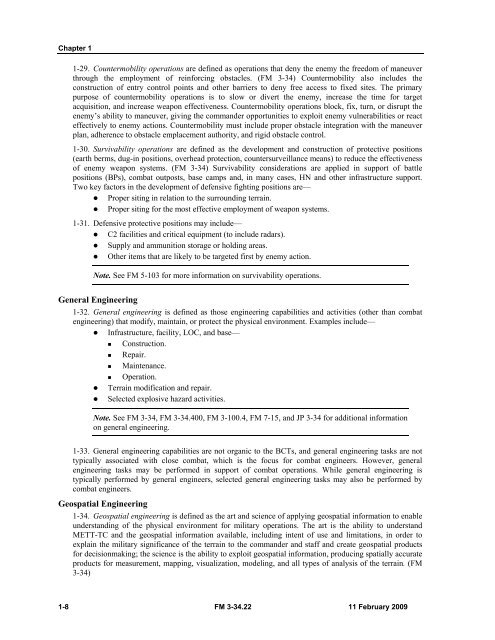FM 3-34.22 - Army Electronic Publications & Forms - U.S. Army
FM 3-34.22 - Army Electronic Publications & Forms - U.S. Army
FM 3-34.22 - Army Electronic Publications & Forms - U.S. Army
Create successful ePaper yourself
Turn your PDF publications into a flip-book with our unique Google optimized e-Paper software.
Chapter 1<br />
1-29. Countermobility operations are defined as operations that deny the enemy the freedom of maneuver<br />
through the employment of reinforcing obstacles. (<strong>FM</strong> 3-34) Countermobility also includes the<br />
construction of entry control points and other barriers to deny free access to fixed sites. The primary<br />
purpose of countermobility operations is to slow or divert the enemy, increase the time for target<br />
acquisition, and increase weapon effectiveness. Countermobility operations block, fix, turn, or disrupt the<br />
enemy’s ability to maneuver, giving the commander opportunities to exploit enemy vulnerabilities or react<br />
effectively to enemy actions. Countermobility must include proper obstacle integration with the maneuver<br />
plan, adherence to obstacle emplacement authority, and rigid obstacle control.<br />
1-30. Survivability operations are defined as the development and construction of protective positions<br />
(earth berms, dug-in positions, overhead protection, countersurveillance means) to reduce the effectiveness<br />
of enemy weapon systems. (<strong>FM</strong> 3-34) Survivability considerations are applied in support of battle<br />
positions (BPs), combat outposts, base camps and, in many cases, HN and other infrastructure support.<br />
Two key factors in the development of defensive fighting positions are—<br />
� Proper siting in relation to the surrounding terrain.<br />
� Proper siting for the most effective employment of weapon systems.<br />
1-31. Defensive protective positions may include—<br />
� C2 facilities and critical equipment (to include radars).<br />
� Supply and ammunition storage or holding areas.<br />
� Other items that are likely to be targeted first by enemy action.<br />
Note. See <strong>FM</strong> 5-103 for more information on survivability operations.<br />
General Engineering<br />
1-32. General engineering is defined as those engineering capabilities and activities (other than combat<br />
engineering) that modify, maintain, or protect the physical environment. Examples include—<br />
� Infrastructure, facility, LOC, and base—<br />
� Construction.<br />
� Repair.<br />
� Maintenance.<br />
� Operation.<br />
� Terrain modification and repair.<br />
� Selected explosive hazard activities.<br />
Note. See <strong>FM</strong> 3-34, <strong>FM</strong> 3-34.400, <strong>FM</strong> 3-100.4, <strong>FM</strong> 7-15, and JP 3-34 for additional information<br />
on general engineering.<br />
1-33. General engineering capabilities are not organic to the BCTs, and general engineering tasks are not<br />
typically associated with close combat, which is the focus for combat engineers. However, general<br />
engineering tasks may be performed in support of combat operations. While general engineering is<br />
typically performed by general engineers, selected general engineering tasks may also be performed by<br />
combat engineers.<br />
Geospatial Engineering<br />
1-34. Geospatial engineering is defined as the art and science of applying geospatial information to enable<br />
understanding of the physical environment for military operations. The art is the ability to understand<br />
METT-TC and the geospatial information available, including intent of use and limitations, in order to<br />
explain the military significance of the terrain to the commander and staff and create geospatial products<br />
for decisionmaking; the science is the ability to exploit geospatial information, producing spatially accurate<br />
products for measurement, mapping, visualization, modeling, and all types of analysis of the terrain. (<strong>FM</strong><br />
3-34)<br />
1-8 <strong>FM</strong> 3-<strong>34.22</strong> 11 February 2009

















